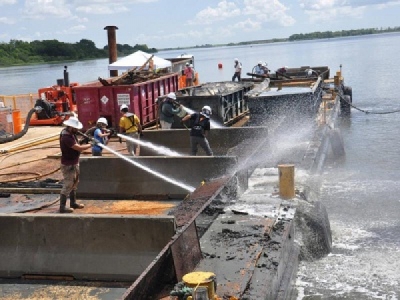
Posted on July 31, 2017
By Mary Carr Mayle, BiS
Although the physical evidence is often subtle, progress on the Savannah Harbor Expansion Project — or SHEP — continues at a steady pace, according to the U.S. Army Corps of Engineers, which has primary responsibility for the nearly $1 billion effort to deepen the Savannah River channel.
This week the Corps announced it has completed an important navigation feature, the $6.5 million raising of a dike on the South Carolina side of the river to hold the material that will be dredged from the inner harbor floor.
The removal of this material will result in a new channel depth of 47 feet below mean sea level, or 5 feet deeper than its current depth.
The project will allow newer, larger cargo vessels to enter and leave the harbor more easily and with heavier loads than currently allowed.
The dike-raising, a 400-day effort, used approximately 500,000 cubic yards of fill material to increase the height of the containment walls, adding substantial capacity to the containment area known as 14A.
With the completion of the raised dike, the groundwork is prepared for beginning SHEP’s most significant feature — inner harbor dredging.
Based on the current schedule, inner harbor dredging could begin in the latter half of 2018, according to Corps spokesman Russell Wicke, who said that schedule is contingent upon the completion and testing of the Dissolved Oxygen Injection System.
The system, designed to offset the decrease in river oxygen levels a deeper river will bring, is currently 45-percent complete and should be finished by the end of the year, he said.
“We are highly confident the DO system will operate in the way our model predictions indicated,” he added.
Mackie McIntosh, chief of Civil Works in the Corps’ Savannah District, said the sooner SHEP is completed, the quicker the nation will realize its full economic benefits — an estimated net value of $282 million every year.
“The completion of our first navigation feature is an indicator that this project is on its way to yielding a large return on investment, not only for Savannah and the southeast but also for the nation,” she said.
The district has also recently completed two environmental mitigation features of the SHEP:
The acquisition and transfer of 2,256 acres of wetlands to the U.S. Fish and Wildlife Service earlier in July, and
A payment of $2.9 million in March 2015 for additional striped bass stocking in the river.
Source: BiS





